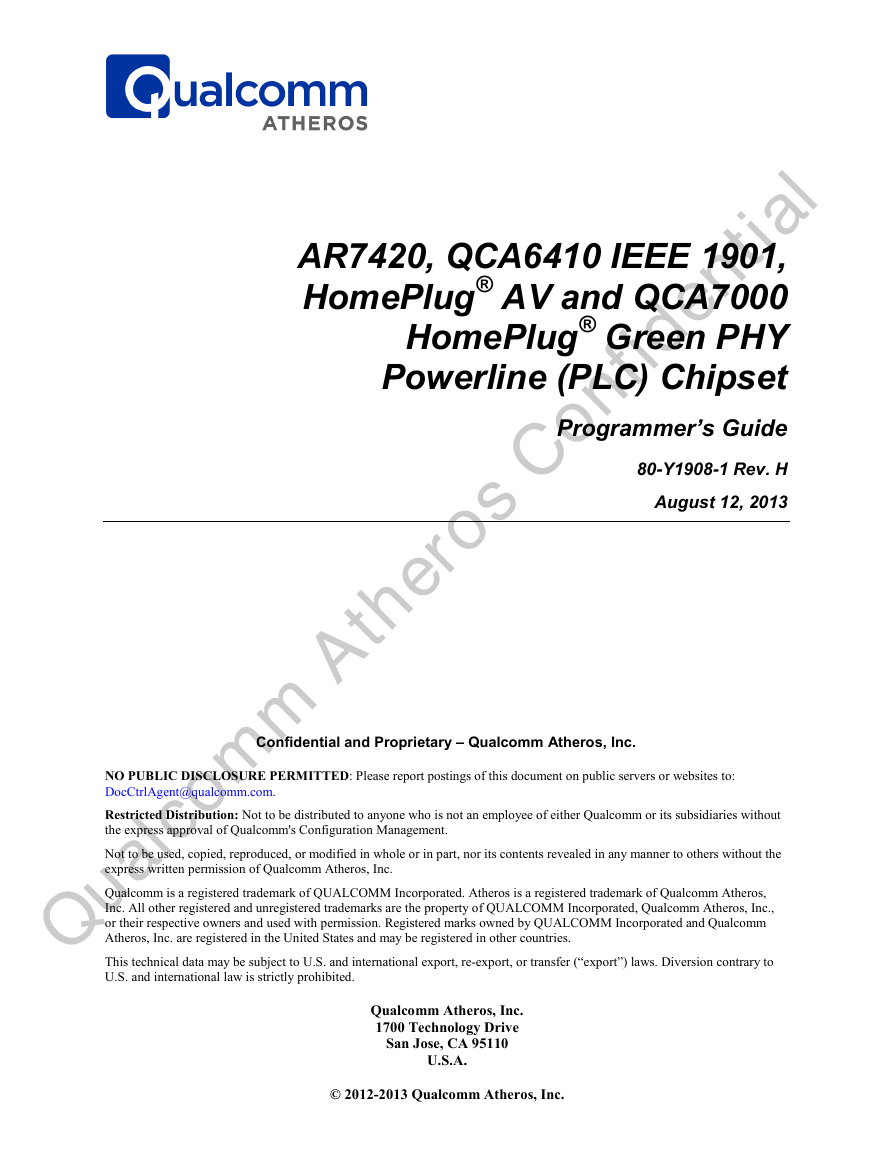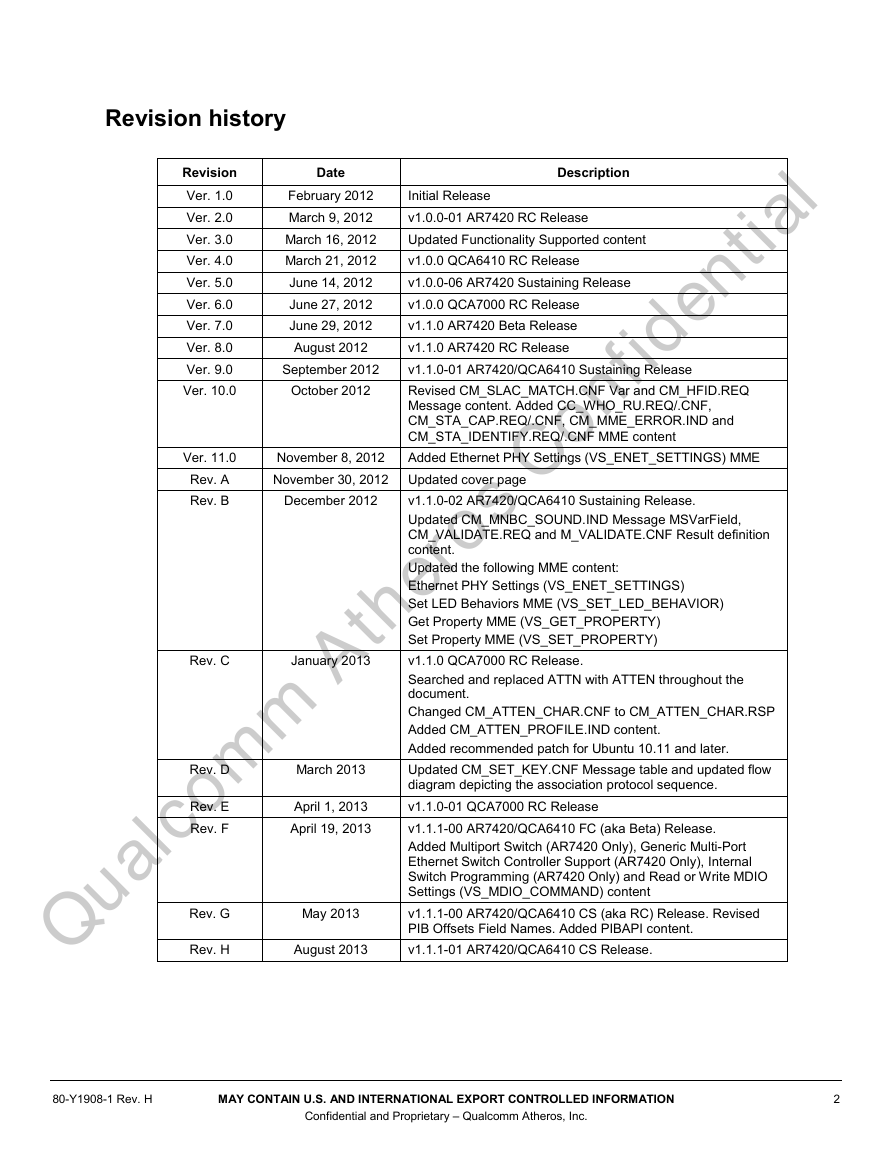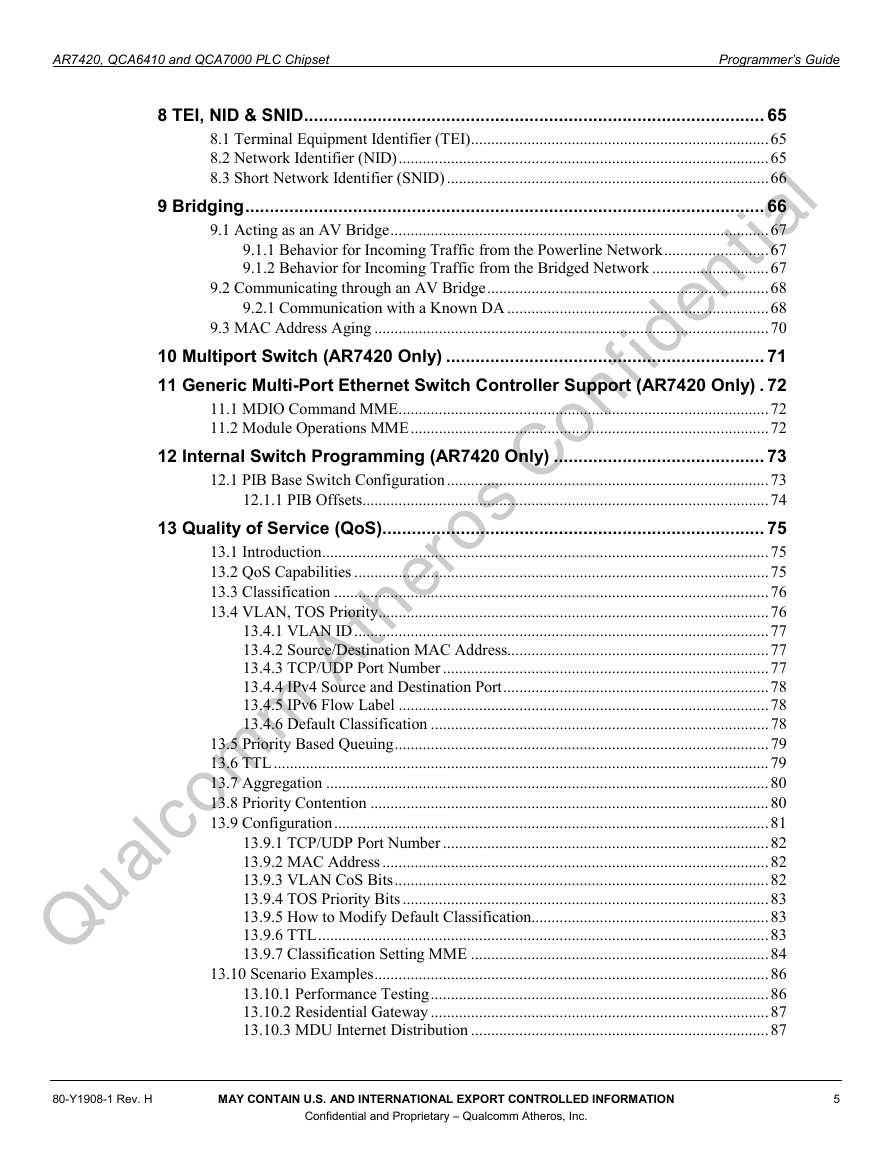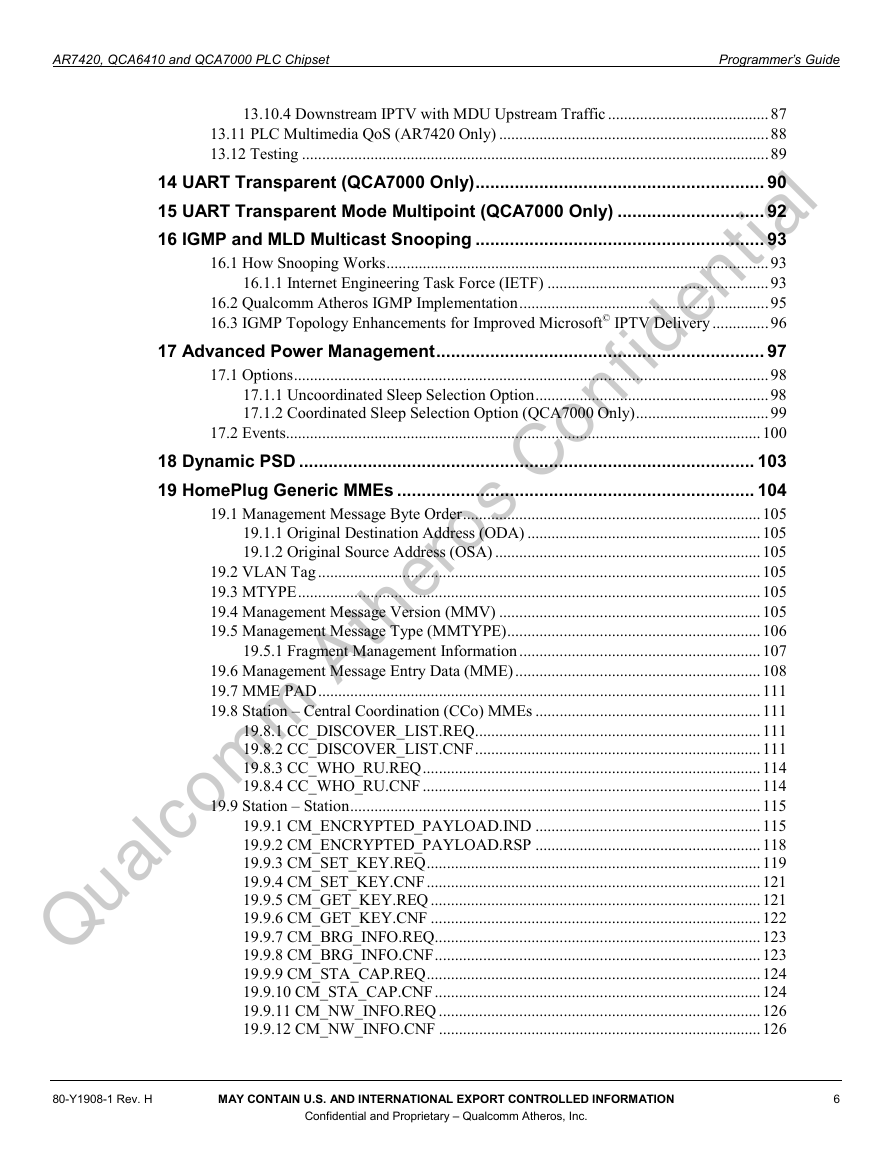Functionality Supported:
1 Architecture Overview
1.1 Powerline Frequency
1.2 Device Components
1.3 Design Considerations
1.4 Differences between the Ethernet/MII and SPI Slave Host Interfaces
1.5 Supported Flash Devices
2 NVM File Formats
2.1 Data Structures
2.1.1 NVM Chain
2.1.2 NVM Header
2.1.3 Modules
2.1.4 NVM Chain Manifest
2.1.5 NVM Chain Traversal
2.1.6 Checksum Calculation
3 Boot Process
3.1 Boot from Flash
3.2 Device Identification
3.3 Boot from Host
3.3.1 Extracting Modules from Firmware NVM Chain
3.3.2 Boot from Host Procedure
3.4 Major Boot Loader changes Compared to Previous Chips
3.5 Caveats
3.6 Initial Provisioning using AVitar
3.6.1 Installation and Start the AVitar Application
3.6.2 Initial Provisioning of Blank Flash Devices
3.6.2.1 Booting Firmware from Host
3.6.2.2 Writing Firmware and PIB into NVM
3.6.2.3 Dual Firmware in Flash
3.7 Module Operations
3.7.1 Overview
3.7.2 Updating the PIB
3.7.2.1 Merge
3.7.2.2 Replace (with Personalization)
3.7.2.3 Replace (Unconditional)
3.7.3 Module Operations for Reading Module Content
3.7.3.1 PIB Read
3.7.4 Module Operations for Flashless Devices (No NVM)
3.7.4.1 Major Changes from Previous Design
3.7.4.2 Powerline PIB-Only Update
3.7.4.2.1 Successful Powerline PIB Only Update
3.7.4.2.2 Error Cases
3.7.4.3 Powerline PIB and Firmware Update
3.7.4.4 PIB Merge Operation via Embedded Host
3.7.4.4.1 Successful PIB Merge Process
3.7.4.4.2 Error Cases
3.7.5 Module Operations for Devices with Flash (NVM)
3.7.5.1 Firmware and PIB Update for Devices with NVM
3.7.5.2 PIB Only Update for Devices with NVM
3.7.5.3 Production Test System Firmware and PIB Update
3.7.5.4 Initial Provisioning
3.8 Major Changes to Firmware and PIB update Compared to Previous Chips
3.9 Flash Layout
4 PIB Upgrade
4.1 PIB Overview
4.2 Factory Default PIB
4.3 User PIB
4.3.1 Manufacturing
4.3.2 Deployment
4.3.3 Field Upgrade
4.3.4 End-user Settings
5 Encryption
5.1 Device Access Key (DAK)
5.2 Device Password (DPW)
5.3 Network Membership Key (NMK)
5.4 Network Password (NPW)
5.5 Password Hashing
6 Pushbutton Simple Connect
6.1 Introduction
6.2 Logical Networks
6.3 Considerations
6.4 Joining a Network
6.5 Leaving a Network
6.6 Visual Feedback
6.7 Variable Time Limits
6.8 The Ground Rules
6.9 Push Button Timing Customization
6.10 Case 1: Forming a Network
6.11 Case 2: Joining a Network
6.12 Case 3: Leaving a Network
6.13 Case 4: Join Multiple Devices to a Network
6.14 Default Power LED Behavior
7 GPIO/LED Engine
7.1 Introduction
7.1.1 Programmability for Customization
7.2 Programming Restriction on GPIOs
7.3 Push Button Programmability
7.3.1 Simple Connect Function
7.3.2 Reset to Factory Defaults
7.3.3 NMK Randomization
7.3.4 Report GPIO State Change
7.3.5 Request Remote GPIO State Change
7.4 Standby Mode Interaction with Push Button and Connection Quality Diagnostics
7.5 LED Programmability
7.5.1 Multiple Software Events on one LED Behavior
7.5.2 Software Event Definitions
7.5.3 Mapping between Events and LED Behaviors
7.5.4 Creating LED Behaviors
7.6 Power Saving Options
8 TEI, NID & SNID
8.1 Terminal Equipment Identifier (TEI)
8.2 Network Identifier (NID)
8.3 Short Network Identifier (SNID)
9 Bridging
9.1 Acting as an AV Bridge
9.1.1 Behavior for Incoming Traffic from the Powerline Network
9.1.2 Behavior for Incoming Traffic from the Bridged Network
9.2 Communicating through an AV Bridge
9.2.1 Communication with a Known DA
9.2.1.1 Known AV Station
9.2.1.2 Known Bridged Destination
9.2.1.3 Known Multicast Address
9.2.1.4 Unknown Unicast Destination
9.2.1.5 Broadcast Address
9.2.1.6 Unknown Multicast Address
9.3 MAC Address Aging
10 Multiport Switch (AR7420 Only)
11 Generic Multi-Port Ethernet Switch Controller Support (AR7420 Only)
11.1 MDIO Command MME
11.2 Module Operations MME
12 Internal Switch Programming (AR7420 Only)
12.1 PIB Base Switch Configuration
12.1.1 PIB Offsets
13 Quality of Service (QoS)
13.1 Introduction
13.2 QoS Capabilities
13.3 Classification
13.4 VLAN, TOS Priority
13.4.1 VLAN ID
13.4.2 Source/Destination MAC Address
13.4.3 TCP/UDP Port Number
13.4.4 IPv4 Source and Destination Port
13.4.5 IPv6 Flow Label
13.4.6 Default Classification
13.5 Priority Based Queuing
13.6 TTL
13.7 Aggregation
13.8 Priority Contention
13.9 Configuration
13.9.1 TCP/UDP Port Number
13.9.2 MAC Address
13.9.3 VLAN CoS Bits
13.9.4 TOS Priority Bits
13.9.5 How to Modify Default Classification
13.9.6 TTL
13.9.7 Classification Setting MME
13.9.7.1 Special Consideration on storage of the Classification Rule Sets
13.9.7.1.1 Storage of Classification Rules Sets in current runtime DRAM (Volatile)
13.9.7.1.2 Storage of Classification Rule Sets Non-Volatile RAM (PIB)
13.9.7.2 Special Consideration on use of the Classification Rules
13.9.7.2.1 Overview of Use of Classification by the PLC chipset
13.9.7.2.2 Organization of Classification Rule Sets
13.10 Scenario Examples
13.10.1 Performance Testing
13.10.2 Residential Gateway
13.10.3 MDU Internet Distribution
13.10.4 Downstream IPTV with MDU Upstream Traffic
13.11 PLC Multimedia QoS (AR7420 Only)
13.12 Testing
14 UART Transparent (QCA7000 Only)
15 UART Transparent Mode Multipoint (QCA7000 Only)
16 IGMP and MLD Multicast Snooping
16.1 How Snooping Works
16.1.1 Internet Engineering Task Force (IETF)
16.2 Qualcomm Atheros IGMP Implementation
16.3 IGMP Topology Enhancements for Improved Microsoft© IPTV Delivery
17 Advanced Power Management
17.1 Options
17.1.1 Uncoordinated Sleep Selection Option
17.1.2 Coordinated Sleep Selection Option (QCA7000 Only)
17.2 Events
18 Dynamic PSD
19 HomePlug Generic MMEs
19.1 Management Message Byte Order
19.1.1 Original Destination Address (ODA)
19.1.2 Original Source Address (OSA)
19.2 VLAN Tag
19.3 MTYPE
19.4 Management Message Version (MMV)
19.5 Management Message Type (MMTYPE)
19.5.1 Fragment Management Information
19.6 Management Message Entry Data (MME)
19.7 MME PAD
19.8 Station – Central Coordination (CCo) MMEs
19.8.1 CC_DISCOVER_LIST.REQ
19.8.2 CC_DISCOVER_LIST.CNF
19.8.3 CC_WHO_RU.REQ
19.8.4 CC_WHO_RU.CNF
19.9 Station – Station
19.9.1 CM_ENCRYPTED_PAYLOAD.IND
19.9.1.1 Payload Encryption Key Select (PEKS)
19.9.1.2 AVLN Status
19.9.1.3 Protocol ID (PID)
19.9.1.4 Protocol Run Number (PRN)
19.9.1.5 Protocol Message Number (PMN)
19.9.1.6 Initialization Vector (IV) or Universally Unique Identifier (UUID)
19.9.1.7 Length (Len)
19.9.1.8 Random Filler (RF)
19.9.1.9 Management Message (MM) or HLE Payload
19.9.1.10 Cyclic Redundancy Check (CRC)
19.9.1.11 Protocol ID (PID - Encrypted)
19.9.1.12 Protocol Run Number (PRN - Encrypted)
19.9.1.13 Protocol Message Number (PMN - Encrypted)
19.9.1.14 Padding - Encrypted
19.9.1.15 RF Length (RFLen - Encrypted)
19.9.2 CM_ENCRYPTED_PAYLOAD.RSP
19.9.2.1 Result
19.9.3 CM_SET_KEY.REQ
19.9.3.1 Key Type
19.9.3.2 NID
19.9.3.3 New_EKS
19.9.4 CM_SET_KEY.CNF
19.9.5 CM_GET_KEY.REQ
19.9.5.1 Request Type
19.9.5.2 Requested Key Type
19.9.5.3 NID
19.9.6 CM_GET_KEY.CNF
19.9.6.1 Request Type
19.9.6.2 Requested Key Type
19.9.7 CM_BRG_INFO.REQ
19.9.8 CM_BRG_INFO.CNF
19.9.8.1 Bridge TEI (BTEI)
19.9.8.2 Number of Bridge Destination Addresses (NBDA)
19.9.8.3 Bridged Destination Address [i] (BDA[i])
19.9.9 CM_STA_CAP.REQ
19.9.10 CM_STA_CAP.CNF
19.9.11 CM_NW_INFO.REQ
19.9.12 CM_NW_INFO.CNF
19.9.13 CM_NW_STATS.REQ
19.9.14 CM_NW_STATS.CNF
19.9.15 CM_HFID.REQ
19.9.16 CM_HFID_CNF
19.9.17 CM_MME_ERROR.IND
19.10 Green PHY SLAC Protocol
19.10.1 Signal Level Attenuation Characterization
19.10.2 CM_STA_IDENTIFY.REQ
19.10.3 CM_STA_IDENTIFY.CNF
19.10.4 CM_SLAC_PARM.REQ
19.10.4.1 APPLICATION TYPE
19.10.4.2 SECURITY TYPE
19.10.4.3 RUN IDENTIFIER
19.10.4.4 CIPHER SUITE SET SIZE
19.10.4.5 CIPHER SUITE [1] to CIPHER SUITE [N]
19.10.5 CM_SLAC_PARM.CNF
19.10.5.1 M-SOUND_TARGET
19.10.5.2 NUM_SOUNDS
19.10.5.3 Time_Out
19.10.5.4 RESP_TYPE
19.10.5.5 FORWARDING_STA
19.10.5.6 APPLICATION TYPE
19.10.5.7 SECURITY TYPE
19.10.5.8 RUN IDENTIFIER
19.10.5.9 CIPHER SUITE
19.10.6 CM_START_ATTEN_CHAR.IND
19.10.6.1 APPLICATION TYPE
19.10.6.2 SECURITY TYPE
19.10.6.3 ACVarField
19.10.6.4 NUM_SOUNDS
19.10.6.5 Time_Out
19.10.6.6 RESP_TYPE
19.10.6.7 FORWARDING_STA
19.10.6.8 RUN IDENTIFIER
19.10.7 CM_ATTEN_CHAR.IND
19.10.7.1 APPLICATION TYPE
19.10.7.2 SECURITY TYPE
19.10.7.3 ACVarField
19.10.7.4 SOURCE_ADDRESS
19.10.7.5 RUN IDENTIFIER
19.10.7.6 SOURCE IDENTIFIER
19.10.7.7 RESPONDER IDENTIFIER
19.10.7.8 NumSounds
19.10.7.9 ATTEN_PROFILE
19.10.8 CM_ATTEN_CHAR.RSP
19.10.8.1 APPLICATION TYPE
19.10.8.2 SECURITY TYPE
19.10.8.3 ACVarField
19.10.8.4 SOURCE_ADDRESS
19.10.8.5 RUN IDENTIFIER
19.10.8.6 SOURCE IDENTIFIER
19.10.8.7 RESPONDER IDENTIFIER
19.10.9 CM_PKCS_CERT.REQ
19.10.10 CM_PKCS_CERT.CNF
19.10.11 CM_PKCS_CERT.IND
19.10.12 CM_PKCS_CERT.RSP
19.10.13 CM_MNBC_SOUND.IND
19.10.13.1 APPLICATION TYPE
19.10.13.2 SECURITY TYPE
19.10.13.3 MSVarField
19.10.13.4 SENDER IDENTIFIER
19.10.13.5 CNT
19.10.13.6 RUN IDENTIFIER
19.10.13.7 RND
19.10.14 CM_VALIDATE.REQ
19.10.15 CM_VALIDATE.CNF
19.10.16 CM_SLAC_MATCH.REQ
19.10.16.1 APPLICATION TYPE
19.10.16.2 SECURITY TYPE
19.10.16.3 MVFLength
19.10.16.4 Match Variable Field
19.10.17 CM_SLAC_MATCH.CNF
19.10.17.1 APPLICATION TYPE
19.10.17.2 SECURITY TYPE
19.10.17.3 MVFLength
19.10.17.4 Match Variable Field
19.10.18 CM_SLAC_USER_DATA.REQ
19.10.18.1 Broadcast_TLV
19.10.18.2 User_data_TLVs
19.10.18.2.1 TLV
19.10.18.2.2 TLV_TYPE
19.10.18.2.3 TLV_STR_LEN
19.10.18.2.4 TLV_INFO_STR
19.10.18.2.4.1 OUI
19.10.18.2.4.2 Subtype
19.10.18.2.4.3 INFO_STR
19.10.19 CM_ATTEN_PROFILE.IND (GREEN PHY)
19.11 PEV - EVSE Association
19.11.1 PEV – EVSE Association Procedure
19.11.1.1 Configuration of GP stations in PEV and EVSE
19.11.1.2 SLAC
19.11.1.2.1 PEV SLAC
19.11.1.2.2 EVSE SLAC
19.11.1.3 Matching Decision at PEV
19.11.1.4 Validation
19.11.1.5 Inform EVSE of Decision
19.11.1.6 Matching Confirm by EVSE
19.11.1.7 Network Join
19.11.1.8 Amplitude Map exchange
19.11.2 Secure SLAC Overview
19.11.2.1 Public Key Certificates
19.11.3 Exchange of User Data
19.11.4 EVSE Power Save Restrictions
20 Qualcomm Atheros Manufacturer Specific MMEs
20.1 Manufacturer Specific MME Header Format
20.2 Start Push Button Encryption MME (MS_PB_ENC)
21 Qualcomm Atheros Vendor Specific MMEs
21.1 Vendor Specific MMEs Header Format
21.2 Get Device/SW Version MME (VS_SW_VER)
21.2.1 Get Device/SW Version Details/Examples
21.2.1.1 Get Device/SW Version – Expected Return Values for Production ICs
21.3 Get NVM Parameters MME (VS_GET_NVM)
21.4 Reset Device MME (VS_RS_DEV)
21.5 Get Watchdog Report MME (VS_WD_RPT)
21.6 Link Statistics MME (VS_LNK_STATS)
21.7 Network Info MME (VS_NW_INFO)
21.8 Check Points MME (VS_CP_RPT)
21.9 Set Encryption Key Request MME (VS_SET_KEY)
21.10 Get Manufacturer String MME (VS_MFG_STRING)
21.11 Embedded Host Action Requested MME (VS_HST_ACTION)
21.12 Get Device Attributes MME (VS_OP_ATTRIBUTES)
21.13 Ethernet PHY Settings (VS_ENET_SETTINGS)
21.14 Tone Map Characteristics MME (VS_TONE_MAP_CHAR)
21.15 Network Information & Statistics MME (VS_NW_INFO_STATS)
21.16 Reset to Factory Defaults MME (VS_FAC_DEFAULTS)
21.17 Multicast Group Info MME (VS_MULTICAST_INFO)
21.18 Classification Setting MME (VS_CLASSIFICATION)
21.19 Receive Tone Map Characteristics MME (VS_RX_TONE_MAP_CHAR)
21.20 Set LED Behaviors MME (VS_SET_LED_BEHAVIOR)
21.21 Write and Execute Applet MME (VS_WRITE_AND_EXECUTE_APPLET)
21.22 Read or Write MDIO Settings (VS_MDIO_COMMAND)
21.23 Static Neighbor Network Mitigation Operation MME (VS_NN_MITIGATE)
21.24 Module Operation MME (VS_MODULE_OPERATION)
21.25 Diagnostic Network Probe MME (VS_DIAG_NETWORK_PROBE)
21.26 Powerline Link Status MME (VS_PL_LNK_STATUS)
21.27 GPIO State Change MME (VS_GPIO_STATE_CHANGE)
21.28 Multi-Port Link Status MME (VS_MULTIPORT_LNK_STA)
21.29 Standby MME (VS_STANDBY)
21.30 Sleep Schedule MME (VS_SLEEPSCHEDULE)
21.31 Sleep Schedule Notification MME (VS_SLEEPSCHEDULE_NOTIFICATION)
21.32 Microcontroller Diagnostics MME (VS_MICROCONTROLLER_DIAG)
21.33 Get Property MME (VS_GET_PROPERTY)
21.34 Set Property MME (VS_SET_PROPERTY)
21.35 Attenuation Characteristics MME (VS_ATTEN_CHAR)
22 QCA7000 SPI Device Driver
22.1 SPI Frame Encapsulation
22.2 SPI Requirements
22.3 SPI Transfers
22.4 Legacy vs. Burst Transfer Modes
22.5 Write Buffer Sequence
22.5.1 Register List and Control Bits
22.5.2 Reading an QCA7000 Register over SPI
22.5.3 Writing an QCA7000 Register over SPI
22.5.4 Writing a Packet over SPI
22.6 How is a SPI Frame Constructed?
22.7 Basic Network Driver Operations for QCA7000 SPI Interface
22.8 Handling the QCA7000 Interrupt
22.9 Consider Enabling All Interrupts
22.10 Handling Initialization
22.11 Transmit Considerations
22.12 Receive Considerations
22.13 Known QCA7000 Differences from the PL14
23 QCA7000 UART Interface
23.1 UART Frame Encapsulation
23.2 UART Requirements
23.3 UART Driver Architecture
24 Building a Virtual Machine for the PL16
24.1 Why a Virtual Machine?
24.2 Download VMware Player
24.3 Download Ubuntu 10.10 LTS
24.4 Install WMware Player™
24.5 Install Ubuntu on VMware Player
24.5.1 Create New Virtual Machine
24.5.2 Enter Ubuntu Username and Password
24.5.3 Name the Virtual Machine and Location
24.5.4 Specify Virtual Disk Capacity
24.5.5 Customize Hardware
24.5.6 Ignore Warning Message
24.5.7 Login to Ubuntu
24.6 Share Host File Folders
24.7 Connect to the Network
24.8 Install Extra Ubuntu Packages
24.9 What’s Next?
25 Program the PL16 Device using Binaries
25.1 Obtain QCA PL16 Binary Archive
25.2 Extract the Binary Archive
25.3 Write Bootable Image
26 Compile PL16 Software from Source
26.1 Download Freescale Board Support Package
26.2 Obtain QCA Archives and Script Files
26.3 Copy Board Support Packages to Home Folder
26.4 Enable Special Permissions
26.5 Extract the Freescale Board Support Package
26.6 Install Freescale LTIB
26.7 Install Freescale Scripts
26.8 Build Freescale Image
26.8.1 Select Freescale iMX Platform Series
26.8.2 Select iMX28 Software Stack
26.8.3 Select Freescale i.MX28 Platform
26.8.4 Configure iMX28 Board Settings
26.8.5 Build LTIB Packages
26.9 Install QCA Source Package
26.10 Write Bootable Image
26.10.1 Ubuntu 11.10
27 QCA Installation Scripts
27.1 Environment
27.2 QCA-PL16-extra.sh
27.3 QCA-PL16-setup.sh
27.4 QCA-PL16-patch.sh
28 Overview of PL16 Software
28.1 Software Boot Sequence
28.2 File System Layout
28.3 PL16 Configuration
28.3.1 SPI Driver
28.3.1.1 Resource Requirements
28.3.2 UART Driver
28.3.2.1 Resource Requirements
29 PIB API
29.1 Namespace
29.2 Programming Guidelines
29.3 Getters and Setters Functions
















 2023年江西萍乡中考道德与法治真题及答案.doc
2023年江西萍乡中考道德与法治真题及答案.doc 2012年重庆南川中考生物真题及答案.doc
2012年重庆南川中考生物真题及答案.doc 2013年江西师范大学地理学综合及文艺理论基础考研真题.doc
2013年江西师范大学地理学综合及文艺理论基础考研真题.doc 2020年四川甘孜小升初语文真题及答案I卷.doc
2020年四川甘孜小升初语文真题及答案I卷.doc 2020年注册岩土工程师专业基础考试真题及答案.doc
2020年注册岩土工程师专业基础考试真题及答案.doc 2023-2024学年福建省厦门市九年级上学期数学月考试题及答案.doc
2023-2024学年福建省厦门市九年级上学期数学月考试题及答案.doc 2021-2022学年辽宁省沈阳市大东区九年级上学期语文期末试题及答案.doc
2021-2022学年辽宁省沈阳市大东区九年级上学期语文期末试题及答案.doc 2022-2023学年北京东城区初三第一学期物理期末试卷及答案.doc
2022-2023学年北京东城区初三第一学期物理期末试卷及答案.doc 2018上半年江西教师资格初中地理学科知识与教学能力真题及答案.doc
2018上半年江西教师资格初中地理学科知识与教学能力真题及答案.doc 2012年河北国家公务员申论考试真题及答案-省级.doc
2012年河北国家公务员申论考试真题及答案-省级.doc 2020-2021学年江苏省扬州市江都区邵樊片九年级上学期数学第一次质量检测试题及答案.doc
2020-2021学年江苏省扬州市江都区邵樊片九年级上学期数学第一次质量检测试题及答案.doc 2022下半年黑龙江教师资格证中学综合素质真题及答案.doc
2022下半年黑龙江教师资格证中学综合素质真题及答案.doc